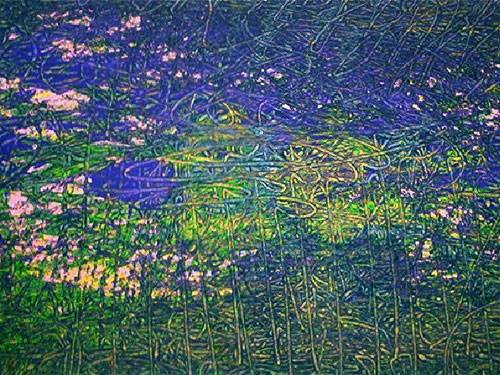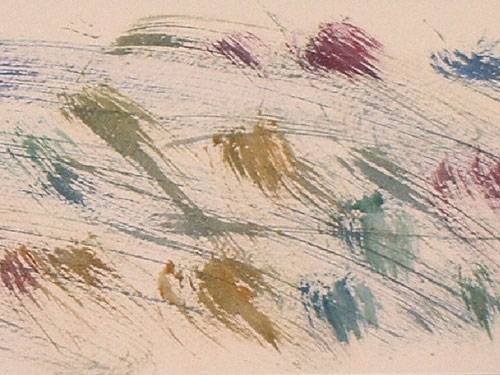 The work on display in the current art exhibit at the University YMCA is beautiful, but that’s only part of the story. The exhibit is called ABILITY: An exhibition of the artwork of Swann Special Care Center residents and is part of the Art @ the Y program at the University YMCA. The exhibit is free and runs until February 18th.
The work on display in the current art exhibit at the University YMCA is beautiful, but that’s only part of the story. The exhibit is called ABILITY: An exhibition of the artwork of Swann Special Care Center residents and is part of the Art @ the Y program at the University YMCA. The exhibit is free and runs until February 18th.
The artists
Swann Special Care Center is located in west Champaign and is a long-term care facility for individuals with profound disabilities ― both mental and physical. There are over one hundred residents at Swann, and they vary in age from infants to the elderly. Only a few of the residents can walk without assistance. Only a few can hold a conversation in a conventional manner. Some were born the way they are. Others became that way because of accidents, health complications, or abuse.
The art program
One of the challenges for the caregivers at Swann is finding activities in which the residents can participate meaningfully. For Zipura Matias, the director of Resource Development Center (a Swann parent company-affiliated organization) and a nurse at Swann, coming across an art program about ten years ago in suburban Chicago for individuals with disabilities provided inspiration. “We saw an art program for high functioning individuals and we thought maybe we could develop one for our residents,” Matias said.
Matias consulted with a variety of experts, including speech language therapist Angela Devaney, COTA Sandy Borelli, and now retired UI art professors Don Pilcher and Julia Kellman. The newly formed team began to develop adaptive devices for the resident artists to use, such as special paint brushes that are attached to the hands of residents who can’t hold them on their own. A call for volunteers from the community to help with the classes went out, and ― with the help of a $1,000 grant from the Community Foundation of East Central Illinois ― art supplies were purchased. The program was launched in 2001 and is going strong today.

The idea is for the residents to create the art themselves, although all of them need assistance to some degree. Matias explained: “You let them do the art however possible, but you always start with choice making.”
For example, aroma therapy ― in the form of associating certain scents with certain colors ― is used for residents who are blind in order to help them make choices about what colors to use.
Offering several types of art materials and having the residents feel the different textures before choosing which to work with provides a tactile context that helps them make decisions about how their own pieces develop.
Working with residents on these activities is an art itself. Volunteer teacher Charlotte Brady elaborated:
The residents have certain movements that they do which we play on. For instance, if you take a Japanese brush and put black ink or paint on paper, you can very gently feel their movements. It might be loose; it might be tight. You can feel their rhythms, their movements, and use their body language as a guide. You have to be really sensitive, but that works well.
Matias mentioned that finding the middle ground between helping the residents and doing the art for them is sometimes hard: “Yes, you’re assisting them, but it is theirs. We know when it’s staff artwork and not resident artwork.”
Who and what it’s good for
Creating art brings the same benefits to Swann residents that it does to anyone, but the program is beneficial beyond that.
 Resident artwork decorates the different Swann facility buildings in a personal and colorful way. It’s also given to parents and guardians, many of whom are pleased to have a tangible representation of what their child or ward was able to create. “Almost all of the guardians and the parents have been appreciative of the work their children have done,” Matias said.
Resident artwork decorates the different Swann facility buildings in a personal and colorful way. It’s also given to parents and guardians, many of whom are pleased to have a tangible representation of what their child or ward was able to create. “Almost all of the guardians and the parents have been appreciative of the work their children have done,” Matias said.
In the early days of the program, artwork in various forms ― prints, cards, etc. ― began to be sold in order to raise funds for supplies. Zipura explained, “Our goal in the beginning was to find a way to make the public aware that our residents can do something, and for that to be a contribution to their community. Yes they have severe disabilities, but they can do something that’s good. The money is secondary.”
As time went on, the program also began to put on gallery showings ― at Parkland and at indi go artist co-op among other locations ― and began to sell artwork at Taste of Champaign-Urbana and at other events.
“In the last few years it seems like it’s kind of caught on. We have had several shows and they’ve been very good. We’ve been out in the limelight and I think more of the community knows about what we’re doing,” Charlotte Brady explained.
Today, any money earned beyond the costs of running the program goes to the recreation center that Swann plans to build for residents next to the main facility at 109 Kenwood Road in Champaign.
Art classes are held once a week on Thursday mornings.
Charlotte Brady has been involved with the program as a volunteer from the start and found that giving her time has been good for her as well as for the residents she assists. Brady, a retired art teacher (mostly in the Mahomet schools), also said that teaching this population brings new challenges to her as an art educator:
I taught art for thirty years to different ages of people. So I bring a lot of experience to it. Finger painting and collages are very common, but we wanted to branch off of that. We had to figure out what they could actually do.
I felt like I had a lot of experience that I wasn’t going to be able to give any more. I had to be creative to think of things that they could do. There’s not any book on it; so I had to use my experience. It was nice to not let that go to waste.
Other volunteers include Nancy Carter and retired art teacher Arlene Rappaport.
In conclusion
 As mentioned, the exhibit at the University YMCA runs until February 18th. Also, information on how to volunteer, donate, or purchase artwork is available on the art program page of the Swann Special Care Center website. Matias stressed that the program is always looking for new volunteers to work in different capacities. Monetary donations are ― obviously ― appreciated as well.
As mentioned, the exhibit at the University YMCA runs until February 18th. Also, information on how to volunteer, donate, or purchase artwork is available on the art program page of the Swann Special Care Center website. Matias stressed that the program is always looking for new volunteers to work in different capacities. Monetary donations are ― obviously ― appreciated as well.
If you choose to buy any of this art, you can just keep it for yourself or use it as a gift. Both work. If you give it to someone else, you can explain ― if you like ― how it’s special. They’ll be able to see for themselves how it’s good.
Disclaimer: I work as a case manager at Swann Special Care Center.








